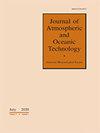GEOS系统中陆地、冰雪和海冰上GMI发射率的反演评估
IF 1.9
4区 地球科学
Q2 ENGINEERING, OCEAN
引用次数: 0
摘要
直接同化陆地、冰雪和海冰上的微波辐射仍然是数据同化系统面临的重大挑战。这些数据同化系统对于包括全球地球观测系统-大气数据同化系统(GEOS-ADAS)在内的全球数值天气预报系统的成功至关重要。在陆地、冰雪上扩展更多的地表敏感微波通道可以为数值天气预报提供所需的数据来源,特别是在行星边界层(PBL)。不幸的是,目前在GEOS-ADAS以及其他数据同化系统中可用的发射率模型的准确性不足以模拟和同化辐射。最近,Munchak等人(2020)发表了一个从全球降水测量(GPM)任务上的GPM微波成像仪(GMI)检索到的微波发射率的5年气候数据库。在本工作中,通过修改GEOS-ADAS数据库,使用该发射率数据库取代社区辐射传输模型(CRTM)中可用的默认发射率值,CRTM是GEOS-ADAS使用的快速辐射传输模型。作为第一步,GEOS-ADAS以所谓的“独立”模式运行,使用默认的CRTM发射率来模拟GMI的辐射,并用Munchak等人2020年的值取代默认的CRTM发射率模型。Munchak等人,2020年模拟的GMI观测结果与GMI的观测结果更接近。这些结果连同对GEOS-ADAS中GMI观测的含义的讨论一起提出。本文章由计算机程序翻译,如有差异,请以英文原文为准。
Assessment of retrieved GMI emissivity over land, snow, and sea ice in the GEOS system
Directly assimilating microwave radiances over land, snow and sea ice remains a significant challenge for data assimilation systems. These data assimilation systems are critical to the success of global numerical weather prediction systems including the Global Earth Observing System-Atmospheric Data Assimilation System (GEOS-ADAS). Extending more surface sensitive microwave channels over land, snow and ice could provide a needed source of data for Numerical Weather Prediction particularly in the Planetary Boundary Layer (PBL). Unfortunately, the accuracy of emissivity models currently available within the GEOS-ADAS along with other data assimilation systems are insufficient to simulate and assimilate radiances. Recently, Munchak et al. (2020) published a 5-year climatological database for retrieved microwave emissivity from the GPM Microwave Imager (GMI) aboard the Global Precipitation Measurement (GPM) Mission. In this work the database is utilized by modifying the GEOS-ADAS to use this emissivity database in place of the default emissivity value available in the Community Radiative Transfer Model (CRTM), which is the fast radiative transfer model used by the GEOS-ADAS. As a first step, the GEOS-ADAS is run in a so-called “stand-alone” mode to simulate radiances from GMI using the default CRTM emissivity, and replacing the default CRTM emissivity models with values from Munchak et al, 2020. The simulated GMI observations using Munchak et al., 2020 agree more closely with observations from GMI. These results are presented along with a discussion of the implication for GMI observations within the GEOS-ADAS.
求助全文
通过发布文献求助,成功后即可免费获取论文全文。
去求助
来源期刊
CiteScore
4.50
自引率
9.10%
发文量
135
审稿时长
3 months
期刊介绍:
The Journal of Atmospheric and Oceanic Technology (JTECH) publishes research describing instrumentation and methods used in atmospheric and oceanic research, including remote sensing instruments; measurements, validation, and data analysis techniques from satellites, aircraft, balloons, and surface-based platforms; in situ instruments, measurements, and methods for data acquisition, analysis, and interpretation and assimilation in numerical models; and information systems and algorithms.

 求助内容:
求助内容: 应助结果提醒方式:
应助结果提醒方式:


